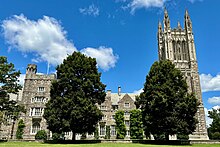Educational architecture, school architecture or school building design is a discipline which practices architect and others for the design of educational institutions, such as schools and universities, as well as other choices in the educational design of learning experiences. The design of building can significantly influence the learning experience of students.[1] Additionally, because schools are important sources of traffic, employment and community activities, school buildings often act as anchor institutions in neighborhoods or communities.[2][3] The decline of a school can have significant impact on local communities.

Various countries have gone through significant changes in philosophies associated with educational institutions, influenced by trends in investment by governments as well as larger changes in educational philosophy.
Scope
editThough primarily dealing with the physical building where education is given, for example a school. Educational An educational architect can therefore also be someone without an official architect's title.[4] Both the methodical as the physical structure of the education influence the learning outcomes.[5]
Examples of educational architecture as redesign of the physical place are
- learning places instead of classrooms,[6]
- applying standards for the indoor environment.[7]
Examples of educational architecture as redesign of the education process are
- designing courses,[8]
- the development of a virtual learning environment.[9]
Significant movements
editQueen Anne style
editEdward Robert Robson pioneered the use of Queen Anne style architecture for school buildings. Robson believed Gothic architecture's association with religion was inappropriate for secular education buildings. Robson's beliefs inspired the Auckland Education Board architects Mitchell and Watt who designed many Queen Anne style school buildings.[10][11]
Open classroom design
editAlso
edit- Joseph Fuller, G. Topham Forrest, Sadie Morgan; architects specialised in educational architecture.
- Glenda Lappan, Robert Glaser; educational designers.
- Harvard Graduate Center; innovator of educational architecture
- The Children's Village at the Canuanã School; winner of the award "Best Building of Educational Architecture of the World" (2018)
References
edit- ^ "How educational institutions' architecture shapes young minds". Architectural Digest India. 2021-02-06. Retrieved 2023-10-08.
- ^ "Schools As Anchor Institutions – A Community Organizer's Perspective". Education - Power - Change. 2023-02-05. Retrieved 2023-10-08.
- ^ O’Farrell, Liam; Hassan, Sara; Hoole, Charlotte (2022-12-02). "The university as a Just anchor: universities, anchor networks and participatory research". Studies in Higher Education. 47 (12): 2405–2416. doi:10.1080/03075079.2022.2072480. ISSN 0307-5079.
- ^ Nixon, Robert G. (2006). "Becoming an education architect. How to design a training program that fits your department's needs". Emergency Medical Services. 35 (7): 54–60. PMID 16878749.
- ^ Tanner, C. Kenneth (2000). "The influence of school architecture on academic achievement". Journal of Educational Administration. 38 (4): 309–330. doi:10.1108/09578230010373598.
- ^ Jamieson, Peter (2005). "Moving beyond the classroom: Accommodating the changing pedagogy of higher education" (PDF). Forum of the Australasian Association for Institutional Research. 2005.
- ^ Baker, Lindsay. "A History of School Design and Its Indoor Environmental Standards, 1900 to Today" (PDF). National Institute of Building Sciences. National Clearinghouse for Educational Facilities. Retrieved 22 February 2019.
- ^ Caldwell, Mark S. (1993). "Educational Architecture: Constructing Courses to Meet Learner's Needs and Expectations". Journal of Professional Legal Education. 11 (1): 13.
- ^ Naeve, Ambjörn (October 2001). "The knowledge manifold an educational architecture that supports inquiry-based customizable forms of e-learning" (PDF). CID, Centre for User Oriented IT Design. 2001.
- ^ Francesco, Cara (October 2016). "Heritage Evaluation - Richmond Manual Training School" (PDF). Auckland Council Heritage Unit.
- ^ Reynolds & Associates. "Heritage Evaluation - Newmarket Manual Training School" (PDF). Auckland Council Heritage Unit.
- ^ “Who Thought 'Open Classrooms' Were a Good Idea?”, CityLab, April 27, 2017. Retrieved 2017-10-07